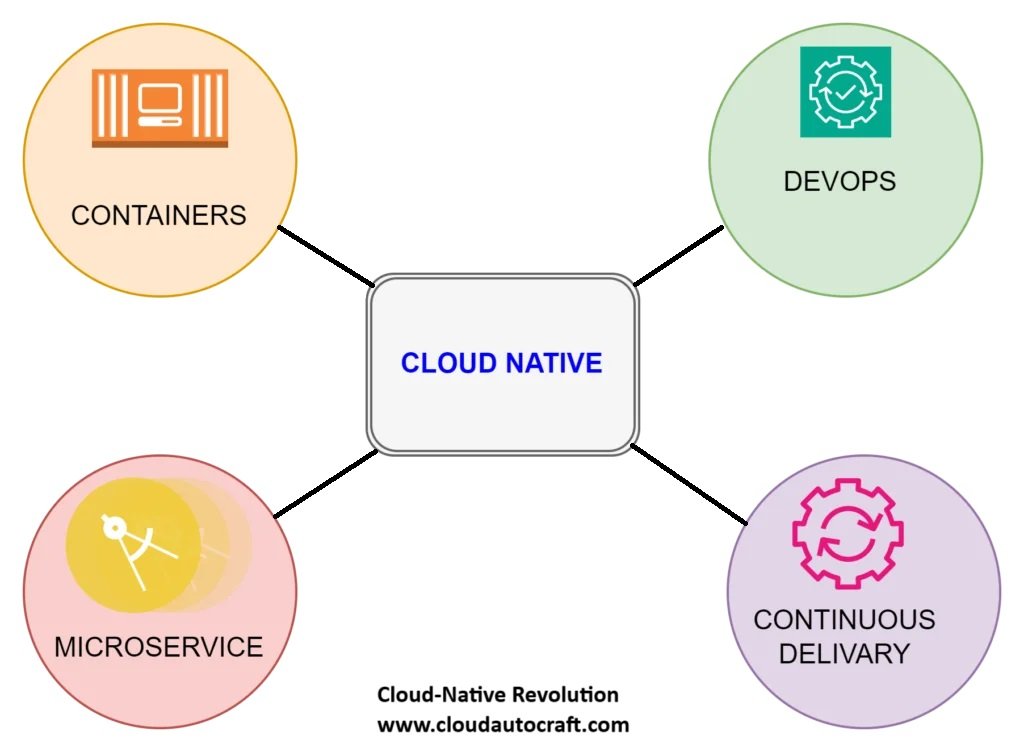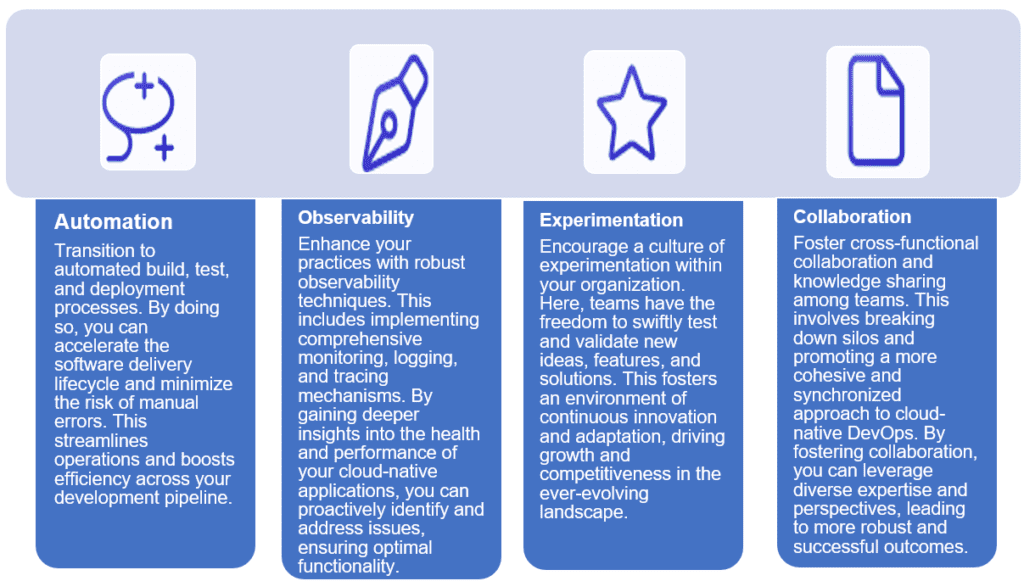The Cloud-native Revolution leverages cloud capabilities to streamline application development, deployment, and management. By embracing principles like containerization, microservices, and automated CI/CD pipelines, organizations can achieve more efficient and responsive software delivery. This approach focuses on dynamically building, deploying, and scaling applications on demand. As a result, businesses can quickly adapt to market changes, reduce infrastructure costs, and ensure high availability and reliability of their systems.
Content:
- Embracing the Cloud-Native Revolution Mindset:
- Key Principles of Cloud-Native Revolution :
- Benefits of Cloud-Native Revolution in DevOps:
- Adopting Cloud-Native Revolution Technologies:
- Cloud-Native Revolution: Overcoming Challenges
- Building a Cloud-Native Revolution Foundation:
- Enabling Continuous Innovation:
- Optimizing Cloud-Native Revolution Operations:
- Embracing a Resilient Architecture
- Driving Continuous Improvement:
- Conclusion
- FAQs:
Embracing the Cloud-Native Revolution Mindset:
Shifting to cloud-native DevOps is a big deal for your company. Firstly, it means teams need to work together in new ways. They have to break down the walls between different groups. Consequently, teams get more say over their projects from start to end. This new approach fosters collaboration and ownership throughout the development process.
This cultural change is crucial for unlocking the full power of cloud-native tech. It lets teams use a more agile, step-by-step approach. They can also focus more on what customers want.
The changes may seem challenging at first. But in the long run, this new way of working will help your company get the most out of cloud-native revolution tools and ideas. Your teams will be more agile, efficient, and in sync with customer needs.

Key Principles of Cloud-Native Revolution :
Containerization
Containers are like little packages for apps and everything they need to run. Therefore, this makes it easy to move the apps around to different places, from testing to production.
Microservices Architecture
Breaking big apps into smaller, independent services is called microservices. Hence, this gives you more flexibility and speed to get things done. The parts can scale up or down as needed.
Automated CI/CD
Automated CI/CD means the computer builds, tests, and deploys the software. No more manual steps – it’s all done automatically for faster, more reliable releases.
Infrastructure as Code
Transitioning to infrastructure as code allows you to automate the setup of your IT infrastructure, such as servers and networks. This method ensures consistency and simplifies scaling operations up or down as needed.
Moreover, leveraging cloud-native tools and concepts enhances agility and flexibility. This approach empowers teams to accelerate their pace, swiftly address customer needs, and maximize the benefits of cloud computing.
Benefits of Cloud-Native Revolution in DevOps:
| Increased Agility | Enhanced Scalability | Improved Reliability |
| The cloud-native revolution gives companies the power to adapt to market changes quickly. Hence, this lets them roll out new features and meet customer needs faster and more flexibly. | Cloud-native apps can quickly scale up or down as needed. They can automatically adjust their resources to keep performing well, even during busy times. | Containers, microservices, and automated CI/CD pipelines make cloud-native systems more fault-tolerant and self-healing. Consequently, this boosts their resilience and uptime, improving overall reliability. |
Adopting Cloud-Native Revolution Technologies:
The cloud-native world is changing fast. There are all kinds of tools and platforms to help with cloud-native DevOps. Here, containerization tools like Docker and Kubernetes. There are also app development frameworks like Spring Boot and Quarkus. Companies have lots of options when building their cloud-native setup.
The big cloud providers – AWS, Azure, and Google Cloud – also have their cloud-native services and tools. These can be easily plugged into the development and deployment process. That makes the whole cloud-native experience even more prosperous.
The key is finding the right mix of cloud-native tools and services for your needs. It can feel like many choices, but it gives you the flexibility to build the perfect cloud-native setup for your company. With the right pieces in place, you can harness the power of the cloud.
Click this video to learn more about Empower of Cloud-Native Technologies!
Cloud-Native Revolution: Overcoming Challenges
Cultural Resistance of Cloud-Native Revolution
Switching to cloud-native DevOps often means a significant change in how the company works. Therefore, it can be challenging to get people to think and work differently. To make it work, teams must become more collaborative, open, and adaptable.
Skills Gap of Cloud-Native Revolution
Adopting cloud-native technologies and practices involves acquiring new skills. Consequently, companies may face challenges in finding individuals with the necessary expertise. However, investing in training can effectively bridge this gap.
Security and Compliance of Cloud-Native Revolution
Keeping cloud-native apps and infrastructure secure and compliant is crucial. Companies have to follow complex rules and watch out for vulnerabilities. Hence, Robust security protocols and staying on top of compliance standards are a must to manage the risks.
Managing Complexity of Cloud-Native Revolution
The cloud-native world has many moving parts—tools, platforms, services, and more. Consequently, navigating all that complexity can make the transition and daily management challenging. However, with careful planning and intelligent decisions, you can streamline operations along with security. Additionally, automation plays a crucial role in working efficiently.
The cloud-native journey has challenges, but companies tackling them can unlock significant benefits. Changing mindsets, building skills, ensuring security, and managing complexity takes effort. But the payoff is worth it in terms of speed, flexibility, and performance.
Building a Cloud-Native Revolution Foundation:
Assess Readiness
Before jumping into cloud-native, looking closely at your company’s current state is essential. Consequently, this means checking your tech, processes, and people. Doing this can help you spot areas that need work and problems that might arise later.
Crafting a Strategy
Having a solid cloud-native strategy is critical to success. Firstly, this strategy should align closely with your business goals and outline the key objectives you want to achieve. Consequently, it provides a clear roadmap to follow as you transition to the cloud, making the process smoother and more coordinated.
Upskill and Empower Teams
Investing in your teams is crucial. Providing training and resources empowers them to utilize cloud-native tech and working methods. Hence, this boosts their skills and helps build a culture of innovation and teamwork.
The cloud-native journey takes preparation and planning. Firstly, assess where you’re starting from to identify what needs to change. Next, craft a clear strategy to guide the transition. Additionally, don’t forget to invest in your people – give them the tools and training to become cloud-native experts. If you do these things, you’ll be well on your way to cloud-native success.
Enabling Continuous Innovation:

Optimizing Cloud-Native Revolution Operations:
Here, a list of optimizing process of Cloud-Native Revolution:
- Implement scalable infrastructure for flexible growth.
- Automate deployment processes to improve efficiency.
- Utilize containerization for easier application management.
- Ensure high availability and reliability with cloud-native architectures.
- Enhance security measures through built-in cloud services.
- Optimize cost management with pay-as-you-go models.
- Leverage serverless computing for streamlined operations and security.
Embracing a Resilient Architecture
Fault Tolerance
When building cloud-native apps, make sure they can handle problems. Add built-in ways to deal with things going wrong. These should keep the apps working well, even when disruptions occur. Subsequently, this helps ensure they are always available and can bounce back quickly.
Self-Healing Capabilities
Build self-healing into your infrastructure and apps. In addition, This lets them automatically detect and fix issues on their own. Therefore, this means there is less need for manual fixes and fewer disruptions. It makes everything run more smoothly and reliably.
Multi-Cloud Portability
Use a multi-cloud approach for more flexibility and backup options. Moreover, this lets your apps deploy and work across different cloud providers. Additionally, it gives you more choices and prevents getting stuck with one vendor. This flexibility and freedom to scale is essential.
Furthermore, the key is building cloud-native systems that can withstand problems and fix themselves. For instance, add fault tolerance, self-healing, and multi-cloud portability. That way, your cloud-native setup will be robust, reliable, and able to adapt as your needs change.

Driving Continuous Improvement:
Measure and Analyze
Start by setting up key performance measures. Then, keep an eye on how your cloud-native tech and apps are performing, how reliable they are, and how cost-effective they are. Closely analyzing this data gives you essential insights into what’s working well and needs improvement.
Iterate and Optimize
Use what you learn from monitoring and analysis to find areas that need work. Then, try new approaches to make things better. Optimizing your cloud-native setup can boost performance, streamline how things run, and drive more innovation.
Adapt and Evolve
Always keep an eye on the latest cloud-native trends and developments. Furthermore, be ready to adjust your strategies and practices to stay ahead of the curve. Therefore, this helps ensure your organization stays agile, competitive, and ready for the future.
Additionally, the key is measuring, analyzing, iterating, and adapting. For instance, set up performance tracking, use the insights to improve things, and stay on top of the latest cloud-native advancements. That way, you can keep your cloud-native systems running at their best.
Conclusion
The cloud-native DevOps journey is always changing. In fact, it’s about constantly learning, adapting, and trying new things. As companies take this journey, they need to monitor how things are going closely. Additionally, they must tackle new challenges and use the latest tools and best practices to stay ahead of the competition.
Furthermore, businesses can become super flexible, scalable, and robust by thinking cloud-natively and carefully investing in their people, tech, and organization. Therefore, this sets them up for lasting success in the fast-paced digital world.
Moreover, the cloud-native DevOps path is all about staying on your toes. For instance, keep checking your progress, face challenges head-on and use the latest and greatest. By doing so, your business will have the agility, power, and resilience to thrive, no matter what the future holds.
Click here to Read more about DevOps-Challenge – 2024
FAQs:
What are the vital advantages of embracing cloud-local DevOps practices?
Answer: Cloud-native DevOps offers many perks, like better agility, scalability, and more resilient apps. So, by using microservices, containers, and orchestration tools, organizations can speed up development, use resources better, and enjoy flexibility across multiple cloud platforms.
How does cloud-native DevOps differ from traditional software development approaches?
Answer: Cloud-native DevOps differs from traditional methods because it uses microservices, infrastructure as code (IaC), and CI/CD. It’s all about automating tasks, scaling quickly, and updating swiftly. Consequently, this helps you launch products faster and adapt smoothly to changing business needs.
What are some common challenges in adopting cloud-native DevOps practices?
Answer: Cloud-native DevOps offers many benefits, but it can be challenging, too. Teams might resist cultural changes and face skill gaps. Managing distributed systems adds complexity. Plus, ensuring security, compliance, and cost control in cloud environments requires careful planning and strategy.
How can organizations get started with cloud-native DevOps?
Answer: To start with cloud-native DevOps, review your current processes, build cross-functional teams, and invest in training. Furthermore, prioritize automation and adopt tools like containers and Kubernetes. Foster a culture of continuous improvement and consider working with experienced partners or consultants for guidance.
Originally posted 2024-05-04 07:18:36.


4 thoughts on “How to Excel in the Cloud-Native Revolution?”